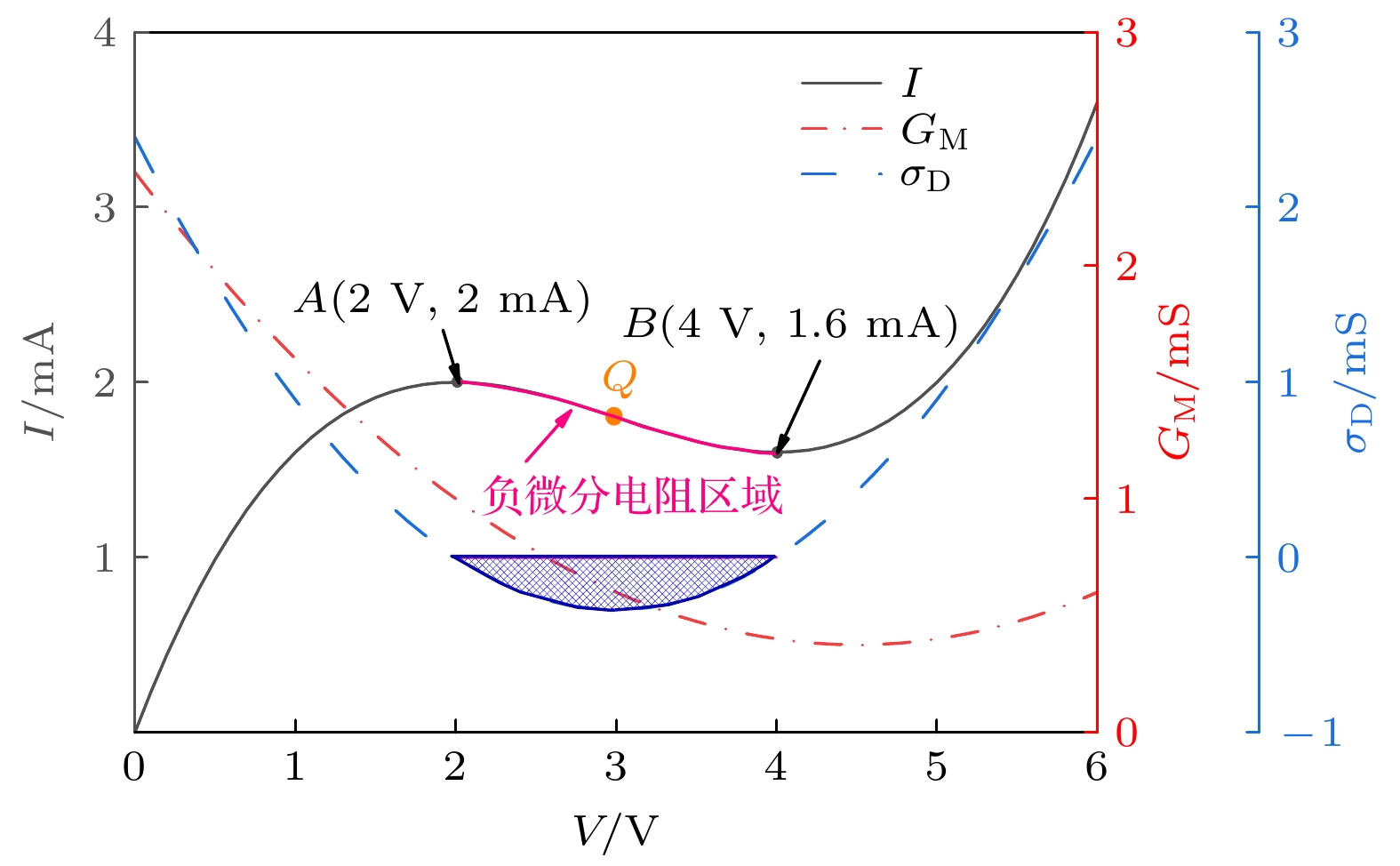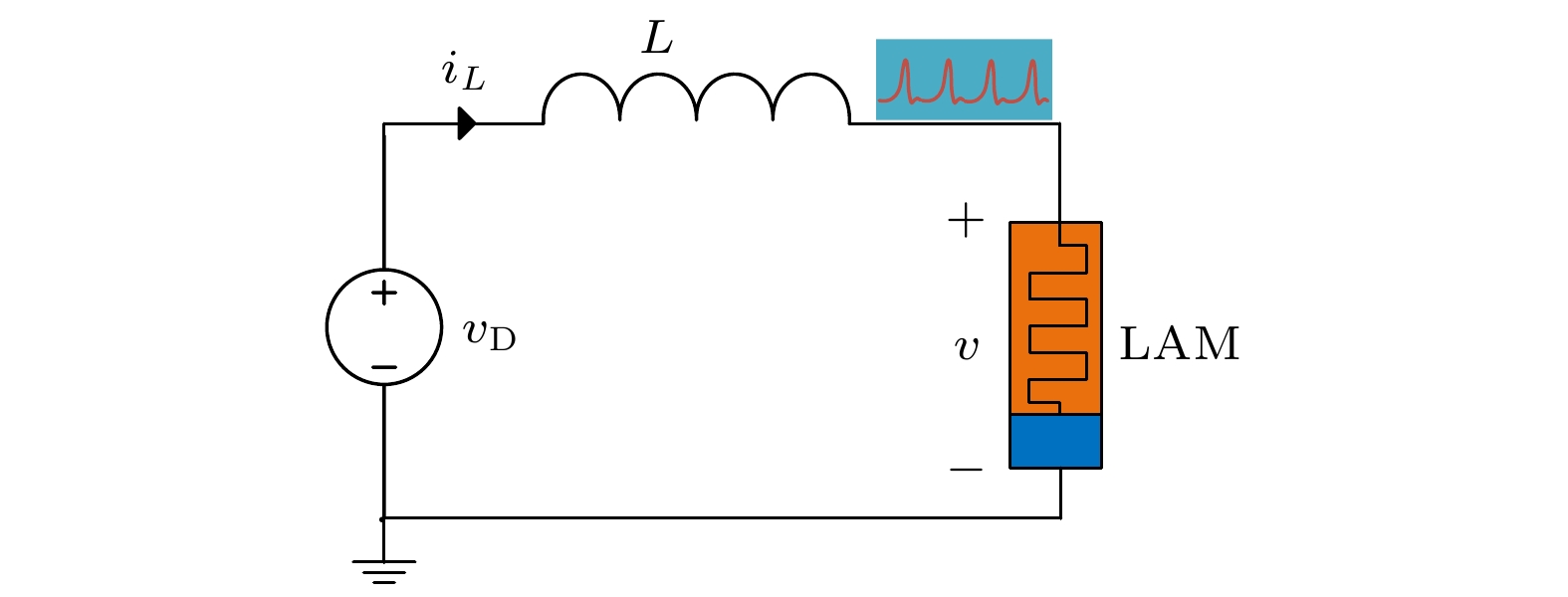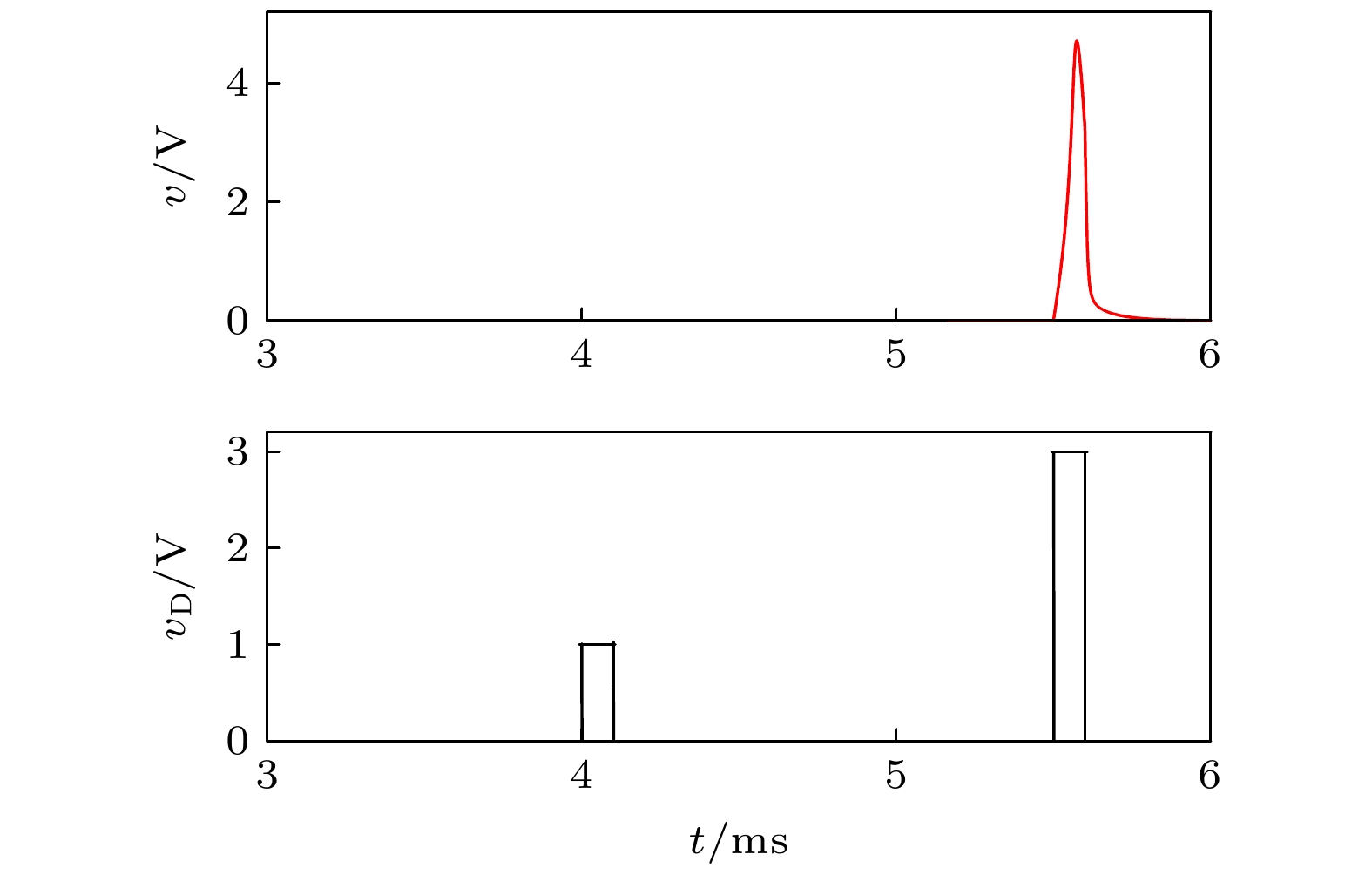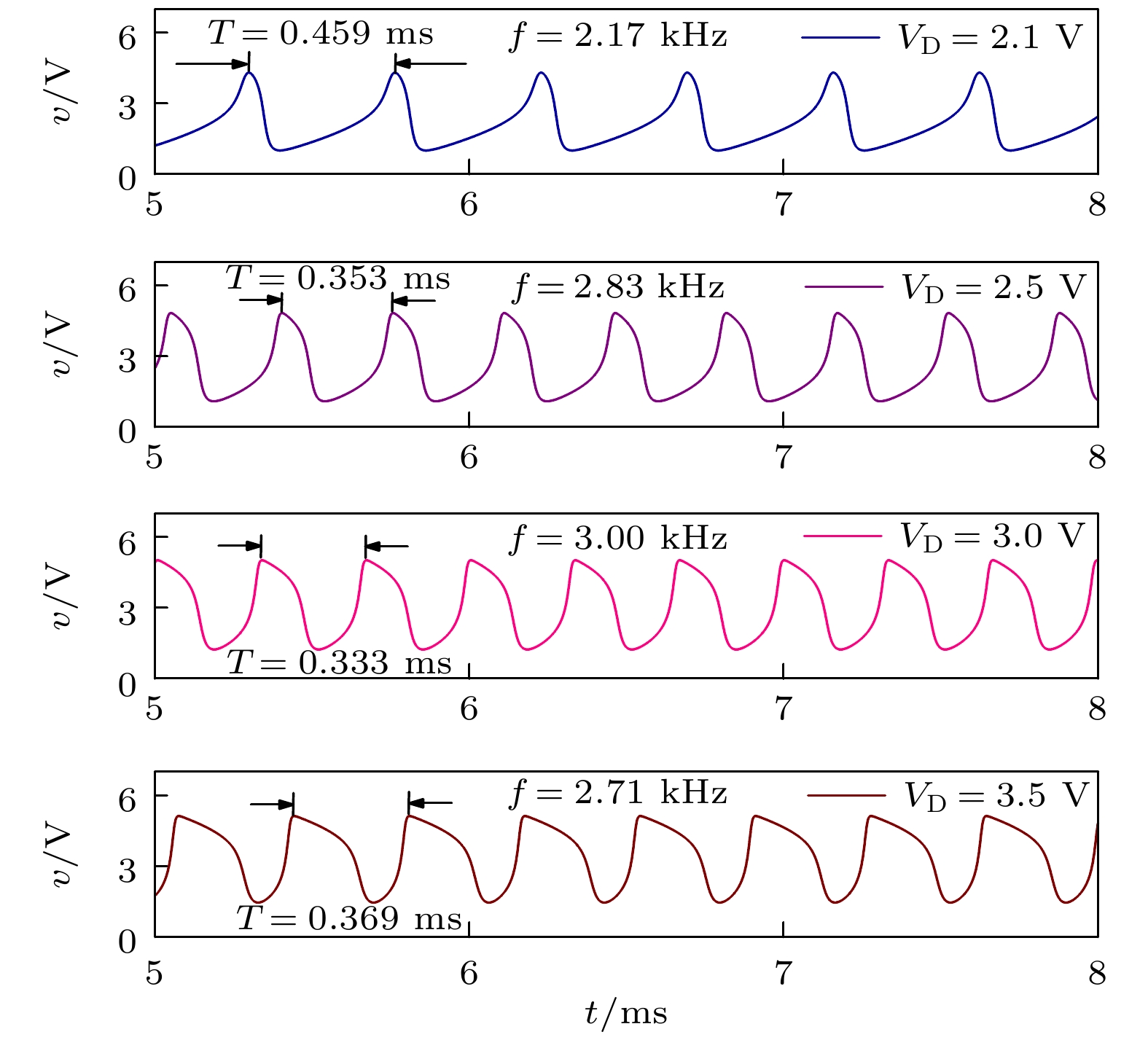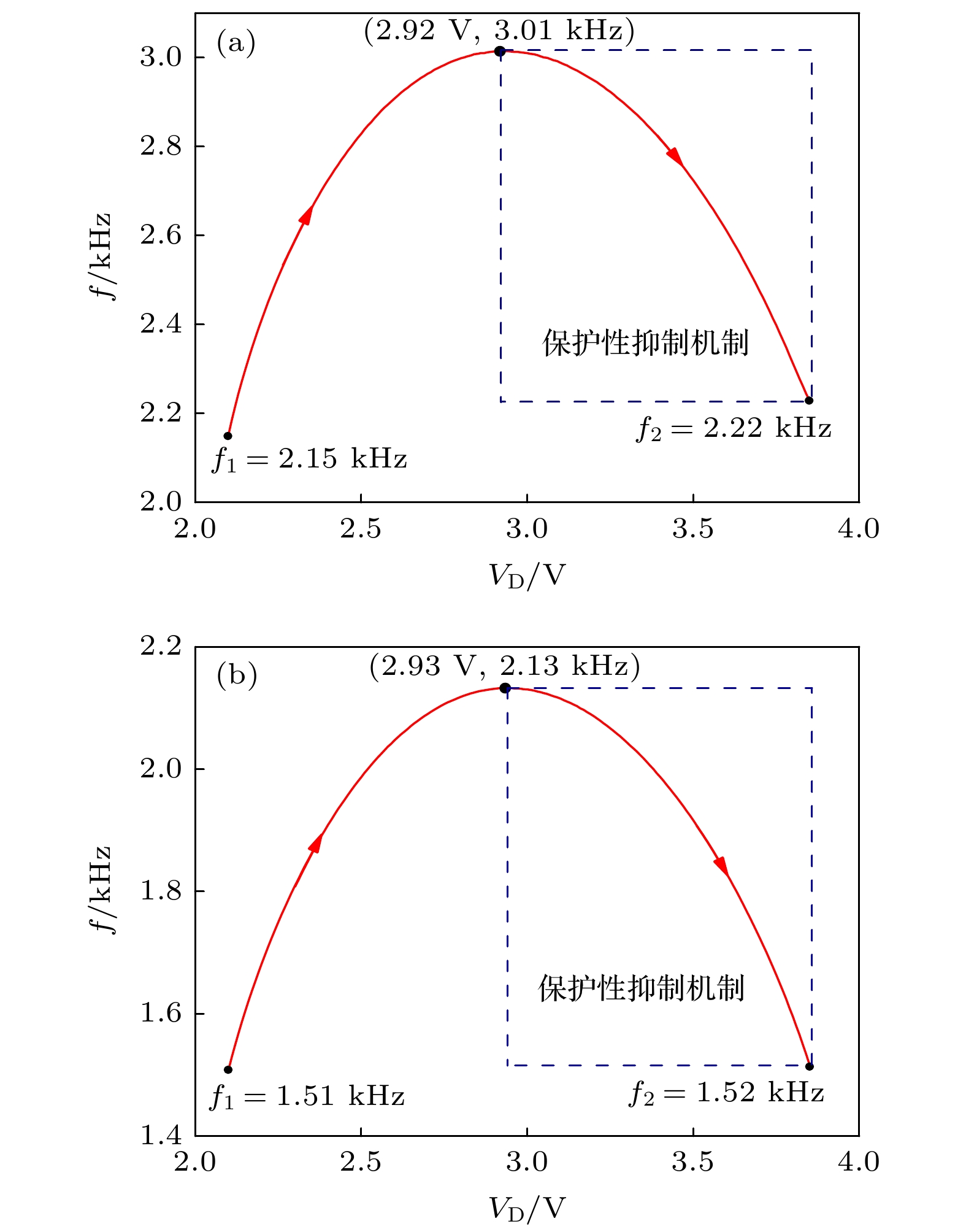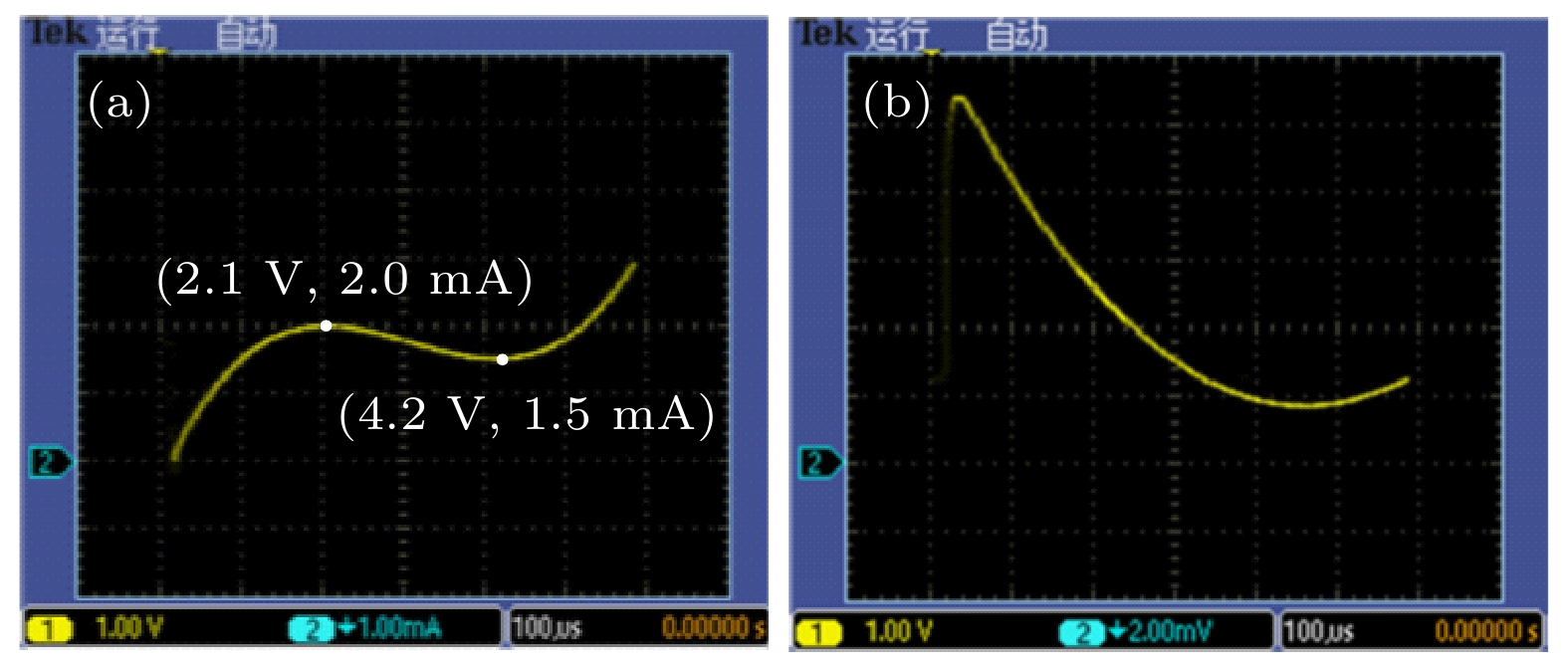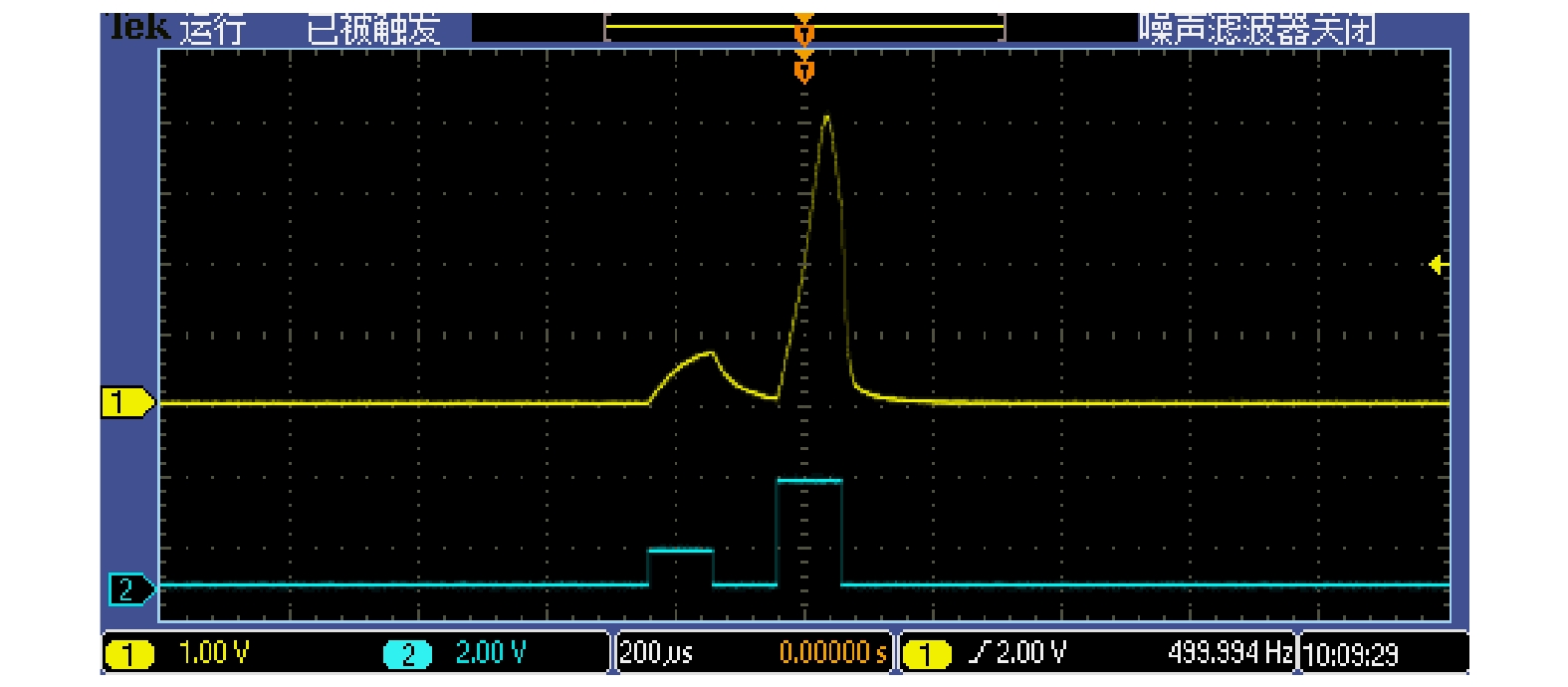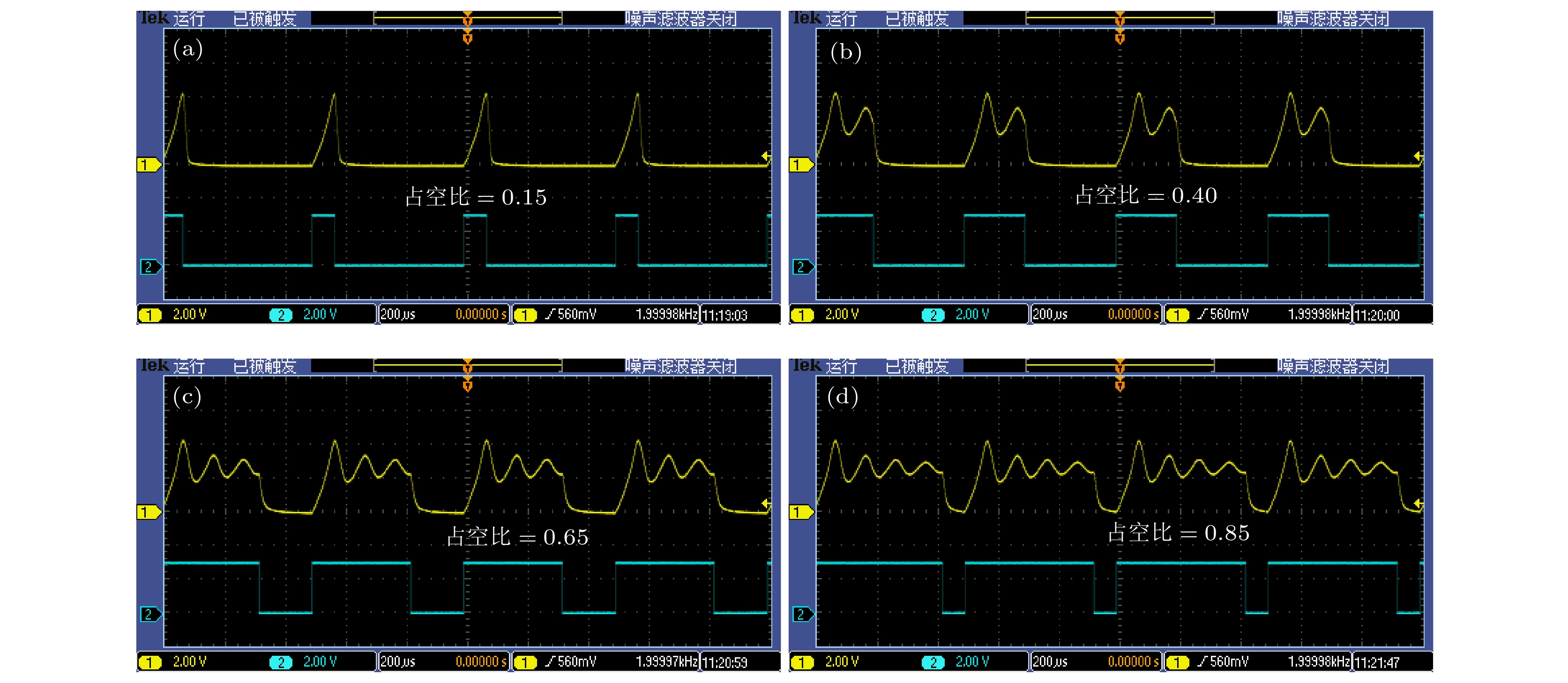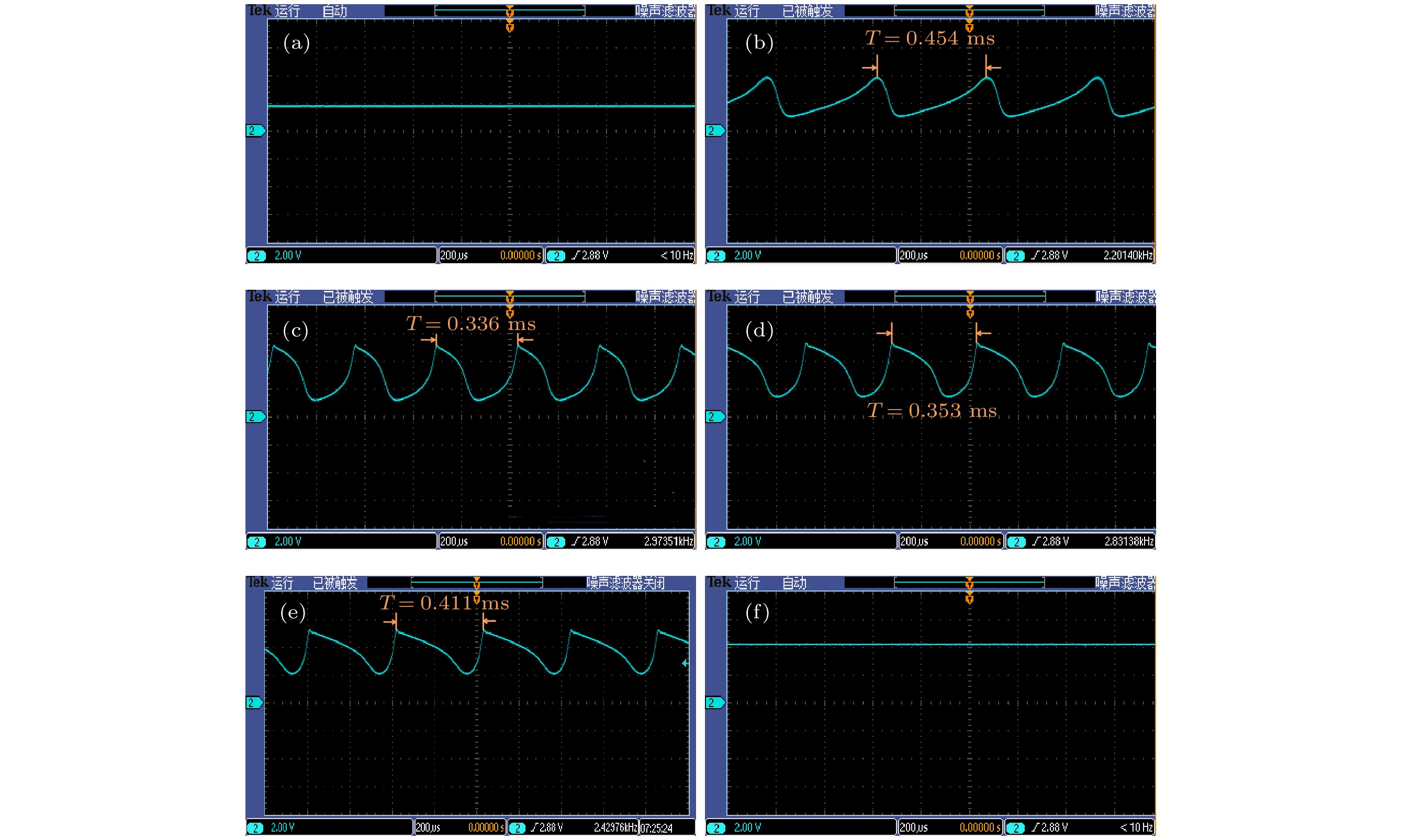-
Owing to the advantages of high integration, low power consumption and locally active characteristics, locally-active memristor (LAM) has shown great potential applications in neuromorphic computing. To further investigate the neuromorphic dynamics of LAMs, a simple N-type LAM mathematical model is proposed in this work. By analyzing its voltage-current characteristic and small-signal equivalent circuit, a neuron circuit based on the N-type LAM is designed, where a variety of neuromorphic behaviors are successfully simulated, such as “all-or-nothing” behavior, spikes, bursting, periodic oscillation, etc. Moreover, Hopf bifurcation theory and numerical analysis method are used to study the dynamics of the circuit quantitatively. Then, an artificial tactile neuron and its frequency characteristics are presented by using the proposed neuron circuit topology. The simulation results show that when the amplitude of the input signal is lower than the threshold, the oscillation frequency of the output signal of the artificial neuron circuit is positively correlated with the intensity of the input signal, and reaches a maximum value at the threshold. The above frequency characteristics are consistent with those of the exciting state of biological sensory system. Subsequently, if the incentive intensity continues to increase, the oscillation frequency will gradually decrease, corresponding to the protective inhibition behavior. Finally, the physical circuit of the N-type LAM, and artificialneuron circuit are realized. The experimental results accord well with the simulation results and theoreticalanalyses, manifesting the practicability of the N-type LAM model and the feasibility of artificial neuron circuit.
-
Keywords:
- memristor /
- local activity /
- neuromorphic /
- Hopf bifurcation /
- hardware implementation
[1] Moore G E 1998 Proc. IEEE 86 82
 Google Scholar
Google Scholar
[2] Backus J 1978 Commun. ACM. 21 613
 Google Scholar
Google Scholar
[3] Zhao Y, Liu B, Yang J, He J, Jiang J 2020 Chin. Phys. Lett. 37 088501
 Google Scholar
Google Scholar
[4] Chen Y-B, Yang X-K, Yan T, Wei B, Cui H-Q, Li C, Cai L 2020 Chin. Phys. Lett. 37 078501
 Google Scholar
Google Scholar
[5] Kumar S, Williams R S, Wang Z 2020 Nature 585 518
[6] Maass W 1997 Neural. Netw. 10 659
 Google Scholar
Google Scholar
[7] Merolla P A, Arthur J V, Alvarez-Icaza R, et al. 2014 Science 345 668
 Google Scholar
Google Scholar
[8] Davies M, Srinivasa N, Lin T H, et al. 2018 IEEE Micro. 38 82
 Google Scholar
Google Scholar
[9] Indiveri G, Linares-Barranco B, Hamilton T J, et al. 2011 Front. Neurosci. 5 73
 Google Scholar
Google Scholar
[10] Kim H, Hwang S, Park J, Yun S, Lee J H, Park B G 2018 IEEE Electron. Device Lett. 39 630
 Google Scholar
Google Scholar
[11] Wang W, Pedretti G, Milo V, Carboni R, Calderoni A, Ramaswamy N, Spinelli A S, Ielmini D 2018 Sci. Adv. 4 eaat4752
 Google Scholar
Google Scholar
[12] Prezioso M, Mahmoodi M R, Bayat F M, Nili H, Kim H, Vincent A, Strukov D B 2018 Nat. Commun. 9 5311
 Google Scholar
Google Scholar
[13] Wang Z, Joshi S, Savel’ev S, et al. 2018 Nat. Electron. 1 137
 Google Scholar
Google Scholar
[14] Roy K, Jaiswal A, Panda P 2019 Nature 575 607
 Google Scholar
Google Scholar
[15] Wang M, Cai S, Pan C, Wang C, Lian X, Zhuo Y, Xu K, Cao T, Pan X, Wang B, Liang S J, Yang J J, Wang P, Miao F 2018 Nat. Electron. 1 130
 Google Scholar
Google Scholar
[16] Pickett M D, Williams R S 2012 Nanotechnology 23 215202
 Google Scholar
Google Scholar
[17] Choi S, Tan S H., Li Z, Kim Y, Choi C, Chen P Y, Yeon H, Yu S, Kim J 2018 Nat. Mater. 17 335
 Google Scholar
Google Scholar
[18] Li C, Hu M, Li Y, et al. 2018 Nat. Electron. 1 52
 Google Scholar
Google Scholar
[19] Hu M, Graves C E, Li C, Li Y, Ge N, Montgomery E, Davila N, Jiang H, Williams R S, Yang J J, Xia Q, Strachan J P 2018 Adv. Mater. 30 1705914
 Google Scholar
Google Scholar
[20] Valov I, Linn E, Tappertzhofen S, Schmelzer S, van den Hurk J, Lentz F, Waser R 2013 Nat. Commun. 4 1771
 Google Scholar
Google Scholar
[21] Wang Z, Rao M, Han J W, et al. 2018 Nat. Commun. 9 3208
 Google Scholar
Google Scholar
[22] Yang Y, Gao P, Li L, Pan X, Tappertzhofen S, Choi S, Waser R, valov I, Lu W D. 2014 Nat. Commun. 5 4232
 Google Scholar
Google Scholar
[23] Liang Y, Wang G, Chen G, Dong Y, Yu D, Iu H H C 2020 IEEE Trans. Circuits. Syst. I. Regul. Pap. 67 5139
 Google Scholar
Google Scholar
[24] Li C, Wang Z, Rao M, Belkin D, Song W, Jiang H, Yan P, Li Y, Lin P, Hu M, Ge N, Stranchan J P, Barnell M, Wu Q, Williams R S, Yang J J, Xia Q 2019 Nat. Mach. Intell. 1 49
 Google Scholar
Google Scholar
[25] Li C, Belkin D, Li Y, Yan P, Hu M, Ge N, Jiang H, Montgomery E, Lin P, Wang Z, Song W, Strachan J P, Barnell M, Wu Q, Williams R S, Yang J J, Xia Q 2018 Nat. Commun. 9 2385
 Google Scholar
Google Scholar
[26] Zhang C, Chen Y, Yi M, Zhu Y, Li T, Liu L, Wang L, Xie L, Huang W 2018 Sci. Sin. Inform. 48 115
 Google Scholar
Google Scholar
[27] Chua L O 2005 Int. J. Bifurcat. Chaos. 15 3435
 Google Scholar
Google Scholar
[28] Mainzer K, Chua L O 2013 Local Activity Principle (London: Imperial College Press)
[29] Midya R, Wang Z, Asapu S, Joshi S, Li Y, Zhuo Y, Song W, Jiang H, Upadhay N, Rao M, Lin P, Li C, Xia Q, Yang J J 2019 Adv. Electron. Mater. 5 1900060
 Google Scholar
Google Scholar
[30] Zhu J, Wu Z, Zhang X, Wang Y, Lu J, Chen P, Cheng L, Shi T, Liu Q 2021 5th IEEE Electron Devices Technology & Manufacturing Conference Chengdu, China, March 9–12, 2021 pp1–3
[31] Al-Shedivat M, Naous R, Cauwenberghs G, Salama K N 2015 IEEE J. Emerg. Sel. Topic. Power Electon. 5 242
 Google Scholar
Google Scholar
[32] Zhang X, Zhuo Y, Luo Q, Wu Z, Midya R, Wang Z, Song W, Wang R, Upadhyay N K, Fang Y, Kiani F, Rao M, Yang Y, Xia Q, Liu Q, Liu M, Yang J J 2020 Nat. Commun. 11 51
 Google Scholar
Google Scholar
[33] Chua L O 2011 Appl. Phys. A 102 765
 Google Scholar
Google Scholar
[34] Liang Y, Lu Z, Wang G, Dong Y, Yu D, Iu H H C 2020 IEEE Access 8 75571
 Google Scholar
Google Scholar
-
图 5 (a) 在VD = 3 V且30 mH ≤ L ≤ 600 mH范围下, 雅可比矩阵特征值的轨迹; (b) 逐步增大电感, 人工神经元电路可振荡条件下, VD范围变化趋势
Figure 5. (a) The trajectory of the Jacobian matrix eigenvalues with VD = 3 V and 30 mH ≤ L ≤ 600 mH; (b) with the artificial neuron circuit can oscillate, the VD range changes trend whereas the inductance increase gradually.
图 8 不同占空比的脉冲激励下, 神经元电路的发放行为波形 (a)占空比 = 0.01; (b)占空比 = 0.1; (c)占空比 = 0.4; (d)占空比 = 0.6; (e)占空比 = 0.8; (f)占空比 = 1.0
Figure 8. The firing behavior waveforms of the neuron circuit under pulse excitation with different duty ratios: (a) Duty ratio = 0.01; (b) duty ratio = 0. 1; (c) duty ratio = 0.4; (d) duty ratio = 0.6; (e) duty ratio = 0.8; (f) duty ratio = 1.0.
图 17 直流偏置VD = 3 V时, 不同电感选择下实验测得人工神经元电路输出v的瞬时时域波形 (a) L = 30 mH; (b) L = 39 mH; (c) L = 47 mH; (d) L = 100 mH; (e) L = 200 mH; (f) L = 300 mH
Figure 17. The experimentally measured instantaneous time-domain waveforms of the artificial neuron circuit output v under different inductances with the DC bias VD = 3 V: (a) L = 30 mH; (b) L = 39 mH; (c) L = 47 mH ; (d) L = 100 mH; (e) L = 200 mH; (f) L = 300 mH
图 18 电感L = 300 mH时, 不同直流偏置选择下实验测得N型LAM两端电压v的瞬时时域波形 (a) VD = 2.5 V; (b) VD = 2.8 V; (c) VD = 3.5 V; (d) VD = 4.0 V; (e) VD = 4.4 V; (f) VD = 4.8 V
Figure 18. The instantaneous time-domain waveforms of the voltage v across the N-type LAM measured under different DC bias selections with the inductance L = 300 mH: (a) VD = 2.5 V; (b) VD = 2.8 V; (c) VD = 3.5 V; (d) VD = 4.0 V; (e) VD = 4.4 V; (f) VD = 4.8 V
表 1 硬件电路参数数值
Table 1. Hardware circuit parameter value.
参数 取值 参数 取值 参数 取值 参数 取值 VCC,Vs/V +15 Ri2/kΩ 40 Rd1/kΩ 2.5 Rin/kΩ 1 VEE/V –15 Rx/kΩ 10 Rd0/kΩ 62.5 Ci/nF 1 Ri1/kΩ 44.44 Rp/kΩ 50 Rw,Rz/kΩ 5 -
[1] Moore G E 1998 Proc. IEEE 86 82
 Google Scholar
Google Scholar
[2] Backus J 1978 Commun. ACM. 21 613
 Google Scholar
Google Scholar
[3] Zhao Y, Liu B, Yang J, He J, Jiang J 2020 Chin. Phys. Lett. 37 088501
 Google Scholar
Google Scholar
[4] Chen Y-B, Yang X-K, Yan T, Wei B, Cui H-Q, Li C, Cai L 2020 Chin. Phys. Lett. 37 078501
 Google Scholar
Google Scholar
[5] Kumar S, Williams R S, Wang Z 2020 Nature 585 518
[6] Maass W 1997 Neural. Netw. 10 659
 Google Scholar
Google Scholar
[7] Merolla P A, Arthur J V, Alvarez-Icaza R, et al. 2014 Science 345 668
 Google Scholar
Google Scholar
[8] Davies M, Srinivasa N, Lin T H, et al. 2018 IEEE Micro. 38 82
 Google Scholar
Google Scholar
[9] Indiveri G, Linares-Barranco B, Hamilton T J, et al. 2011 Front. Neurosci. 5 73
 Google Scholar
Google Scholar
[10] Kim H, Hwang S, Park J, Yun S, Lee J H, Park B G 2018 IEEE Electron. Device Lett. 39 630
 Google Scholar
Google Scholar
[11] Wang W, Pedretti G, Milo V, Carboni R, Calderoni A, Ramaswamy N, Spinelli A S, Ielmini D 2018 Sci. Adv. 4 eaat4752
 Google Scholar
Google Scholar
[12] Prezioso M, Mahmoodi M R, Bayat F M, Nili H, Kim H, Vincent A, Strukov D B 2018 Nat. Commun. 9 5311
 Google Scholar
Google Scholar
[13] Wang Z, Joshi S, Savel’ev S, et al. 2018 Nat. Electron. 1 137
 Google Scholar
Google Scholar
[14] Roy K, Jaiswal A, Panda P 2019 Nature 575 607
 Google Scholar
Google Scholar
[15] Wang M, Cai S, Pan C, Wang C, Lian X, Zhuo Y, Xu K, Cao T, Pan X, Wang B, Liang S J, Yang J J, Wang P, Miao F 2018 Nat. Electron. 1 130
 Google Scholar
Google Scholar
[16] Pickett M D, Williams R S 2012 Nanotechnology 23 215202
 Google Scholar
Google Scholar
[17] Choi S, Tan S H., Li Z, Kim Y, Choi C, Chen P Y, Yeon H, Yu S, Kim J 2018 Nat. Mater. 17 335
 Google Scholar
Google Scholar
[18] Li C, Hu M, Li Y, et al. 2018 Nat. Electron. 1 52
 Google Scholar
Google Scholar
[19] Hu M, Graves C E, Li C, Li Y, Ge N, Montgomery E, Davila N, Jiang H, Williams R S, Yang J J, Xia Q, Strachan J P 2018 Adv. Mater. 30 1705914
 Google Scholar
Google Scholar
[20] Valov I, Linn E, Tappertzhofen S, Schmelzer S, van den Hurk J, Lentz F, Waser R 2013 Nat. Commun. 4 1771
 Google Scholar
Google Scholar
[21] Wang Z, Rao M, Han J W, et al. 2018 Nat. Commun. 9 3208
 Google Scholar
Google Scholar
[22] Yang Y, Gao P, Li L, Pan X, Tappertzhofen S, Choi S, Waser R, valov I, Lu W D. 2014 Nat. Commun. 5 4232
 Google Scholar
Google Scholar
[23] Liang Y, Wang G, Chen G, Dong Y, Yu D, Iu H H C 2020 IEEE Trans. Circuits. Syst. I. Regul. Pap. 67 5139
 Google Scholar
Google Scholar
[24] Li C, Wang Z, Rao M, Belkin D, Song W, Jiang H, Yan P, Li Y, Lin P, Hu M, Ge N, Stranchan J P, Barnell M, Wu Q, Williams R S, Yang J J, Xia Q 2019 Nat. Mach. Intell. 1 49
 Google Scholar
Google Scholar
[25] Li C, Belkin D, Li Y, Yan P, Hu M, Ge N, Jiang H, Montgomery E, Lin P, Wang Z, Song W, Strachan J P, Barnell M, Wu Q, Williams R S, Yang J J, Xia Q 2018 Nat. Commun. 9 2385
 Google Scholar
Google Scholar
[26] Zhang C, Chen Y, Yi M, Zhu Y, Li T, Liu L, Wang L, Xie L, Huang W 2018 Sci. Sin. Inform. 48 115
 Google Scholar
Google Scholar
[27] Chua L O 2005 Int. J. Bifurcat. Chaos. 15 3435
 Google Scholar
Google Scholar
[28] Mainzer K, Chua L O 2013 Local Activity Principle (London: Imperial College Press)
[29] Midya R, Wang Z, Asapu S, Joshi S, Li Y, Zhuo Y, Song W, Jiang H, Upadhay N, Rao M, Lin P, Li C, Xia Q, Yang J J 2019 Adv. Electron. Mater. 5 1900060
 Google Scholar
Google Scholar
[30] Zhu J, Wu Z, Zhang X, Wang Y, Lu J, Chen P, Cheng L, Shi T, Liu Q 2021 5th IEEE Electron Devices Technology & Manufacturing Conference Chengdu, China, March 9–12, 2021 pp1–3
[31] Al-Shedivat M, Naous R, Cauwenberghs G, Salama K N 2015 IEEE J. Emerg. Sel. Topic. Power Electon. 5 242
 Google Scholar
Google Scholar
[32] Zhang X, Zhuo Y, Luo Q, Wu Z, Midya R, Wang Z, Song W, Wang R, Upadhyay N K, Fang Y, Kiani F, Rao M, Yang Y, Xia Q, Liu Q, Liu M, Yang J J 2020 Nat. Commun. 11 51
 Google Scholar
Google Scholar
[33] Chua L O 2011 Appl. Phys. A 102 765
 Google Scholar
Google Scholar
[34] Liang Y, Lu Z, Wang G, Dong Y, Yu D, Iu H H C 2020 IEEE Access 8 75571
 Google Scholar
Google Scholar
Catalog
Metrics
- Abstract views: 9986
- PDF Downloads: 239
- Cited By: 0















 DownLoad:
DownLoad:
